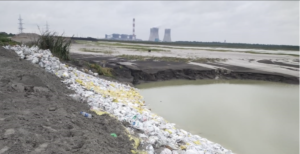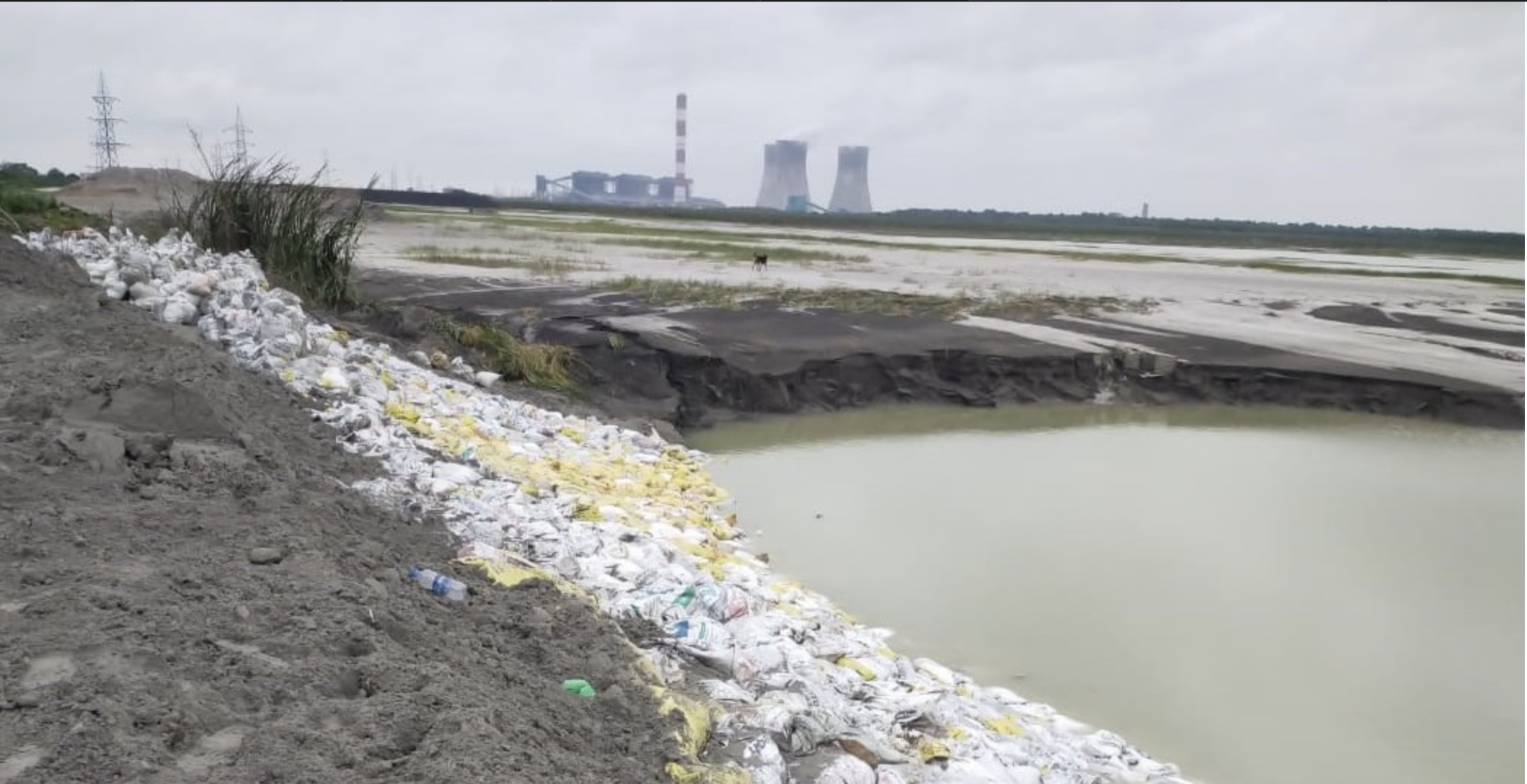 Last month the residents of several villages of Nagpur district woke up to the nightmare of being inundated with fly-ash. Located in the north of Nagpur city are Koradi and Khaparkheda thermal power stations which have their ash dykes in the vicinity. On July 10, 2022 at 3 am, the ash dyke of the Khaparkheda thermal power station broke, leading to ash contaminating the Kanhan river.
Last month the residents of several villages of Nagpur district woke up to the nightmare of being inundated with fly-ash. Located in the north of Nagpur city are Koradi and Khaparkheda thermal power stations which have their ash dykes in the vicinity. On July 10, 2022 at 3 am, the ash dyke of the Khaparkheda thermal power station broke, leading to ash contaminating the Kanhan river.
Though the authorities claimed to have acted quickly and the fly ash dumping in the river was stopped, the claim stood to be misleading and false. Even today, the Kanhan river continues to be polluted with fly-ash, and the water supply to the city is affected.
Not only did ash dyke of the Khaparkheda power station break, on July 16, 2022, the ash bund of the Koradi thermal power plant also broke. Fly-ash and water stored in the dyke gushed downstream to six villages — drowning houses, water bodies and farmlands. With such large-scale devastation, contamination of food, land and water resources, the community is staring at an uncertain future.
The Koradi thermal power station commissioned its first unit in 1974, following which nine other units were constructed, commissioned and decommissioned — the latest being three units of 660 MW capacity each, commissioned every year between 2015 and 2017.
At the time of the accident, only three 660MW units were functional. The power plant’s fly-ash from these three presently functional units was being stored in the Khasala fly-ash dyke spread over 314 hectares.
The Khasala fly-ash dyke, built before2000, has been used to store fly-ash since then. The power plant’s operations have not only impacted the environment and human life over the years of its operations, it has also been violating several environmental norms.
The fly-ash dyke built on the Khairi water stream did not have a high-density polyethylene (HDPE)/ low-density polyethylene (LDPE) lining which would prevent leaching of heavy metals, radioactive substances, and other toxins and chemicals into the surrounding land and groundwater. In addition to not having a lining, the fly-ash dyke, located on the Khairi stream, received monsoon water through the stream.
The fly-ash dyke would act like a dam as well and it formed a lake where the water was being stored till it reached a certain height to be released downstream. In fact, the fly ash-dyke was available to the villagers for fishing till last year, after which fishing in the dam was banned.
Did this stop the villagers from fishing? No! They would fish in the water released from the dam. It was supposed to be a source of nutrition as well as livelihood. Imagine eating the fish that came from a fly-ash dyke laced with radioactive material, chemical toxins and heavy metals! Not only that, the water from the streams was being used to meet day-to-day needs like irrigation.
The study “Polluted Power by Centre For Sustainable Development (CFSD) by Manthan Adhyayan Kendra and Asar” has listed various pollutants found in the natural resources in and around the power plant and their health risks and impacts. The findings are eye opening.
The power plant, despite having several violations, noted by the Ministry of Environment, Forests and Climate Change (MoEF&CC) and the Maharashtra Pollution Control Board (MPCB), continued its operations without any interruption. Not only that, the Koradi thermal power plant was granted terms of reference (ToRs) for further expansion in the year 2020.
Following these incidents, the MPCB went into action and notices were issued to both these power plants and their bank guarantees were forfeited. However, these two fly ash incident aren’t the only ones we have seen.
As per a report published in July 2020 by the Community Environmental Monitoring and Healthy Energy Initiative, India, titled “Coal Ash in India, a Compendium of Disasters, Environmental and Health Risks”, between 2010 and June 2020 about 76 coal ash pond related accidents were reported from across the country.
Eight major coal ash breach accidents took place between August 2019 and May 2021 said a report by the Manthan Adhyayan Kendra “Lest We Forget – A status report of neglect of coal ash accidents in India (May 2019 – May 2021)”.
Despite these major fly-ash incidents, we have not taken any effective steps towards addressing these concerns from the grassroots to the policy. There seems to be lack of administrative and political will to address the concern leading to serious irreversible environmental impacts.
It is surprising that the Khasala fly-ash dyke was allowed to be constructed on a fresh water stream. The poor designing and maintenance of the ash dykes contribute towards the major cause of such accidents. All this, because the policies and administrative processes do not address this issue on priority.
Fly-ash dykes, being a non-productive or non-profit making investment, are at the bottom of every priority list. Design decisions are taken in haste with the intention to save money and space. Maintenance of these ash dykes are also not on priority for similar reasons.
The authorities have also not taken strict action against the power plants for not maintaining the fly ash dykes as needed. For example, for years, the Khaparkheda and Koradi thermal power plants have functioned without having the HDPE lining despite visible ecological and health impacts.
The MoEF&CC issued rules for handling and disposal of fly ash on December 31, 2021. As per the notification, the power plants were allowed to meet 100% utilisation of legacy fly-ash in 10 years, and after that the companies would only be levied fines towards unused fly ash.
The Khasala fly-ash dyke that broke was filled with a whopping 1,46,00,492 MT as on November 30, 2021 as per the MoEF&CC Regional Office Monitoring report dated December 29, 2021.
Fly ash, a toxic end product of coal fired thermal power plants, poses major challenges to humans and the environment. Having millions of tonnes of fly ash disposed on open lands not only leads to the exposure of humans and the environment to the toxic elements but also results into irreversible harmful impacts to our environment, food systems, water sources and our bodies.
It is time we realise, we are not only allowing these power plants to operate with glaring violations, polluting to their full capacities, we are violating the fundamental rights of thousands of our citizens: The right to live with dignity in a safe, clean and secure environment. And all this in the name of national interest? Is this really worth it?
This article was originally published in Counter View and can be read here.
Centre for Financial Accountability is now on Telegram. Click here to join our Telegram channel and stay tuned to the latest updates and insights on the economy and finance.



